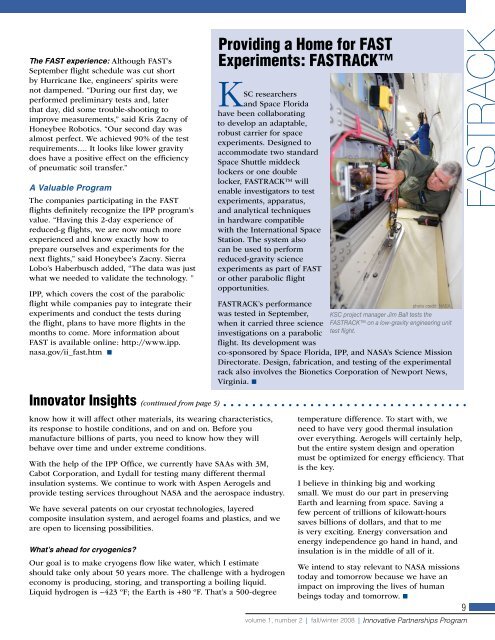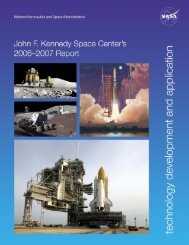Fall-Winter 2008 - Kennedy Space Center Innovative Partnerships ...
Fall-Winter 2008 - Kennedy Space Center Innovative Partnerships ...
Fall-Winter 2008 - Kennedy Space Center Innovative Partnerships ...
Create successful ePaper yourself
Turn your PDF publications into a flip-book with our unique Google optimized e-Paper software.
The FAST experience: Although FAST’s<br />
September flight schedule was cut short<br />
by Hurricane Ike, engineers’ spirits were<br />
not dampened. “During our first day, we<br />
performed preliminary tests and, later<br />
that day, did some trouble-shooting to<br />
improve measurements,” said Kris Zacny of<br />
Honeybee Robotics. “Our second day was<br />
almost perfect. We achieved 90% of the test<br />
requirements…. It looks like lower gravity<br />
does have a positive effect on the efficiency<br />
of pneumatic soil transfer.”<br />
A Valuable Program<br />
The companies participating in the FAST<br />
flights definitely recognize the IPP program’s<br />
value. “Having this 2-day experience of<br />
reduced-g flights, we are now much more<br />
experienced and know exactly how to<br />
prepare ourselves and experiments for the<br />
next flights,” said Honeybee’s Zacny. Sierra<br />
Lobo’s Haberbusch added, “The data was just<br />
what we needed to validate the technology. ”<br />
IPP, which covers the cost of the parabolic<br />
flight while companies pay to integrate their<br />
experiments and conduct the tests during<br />
the flight, plans to have more flights in the<br />
months to come. More information about<br />
FAST is available online: http://www.ipp.<br />
nasa.gov/ii_fast.htm n<br />
Innovator Insights (continued from page 5)<br />
know how it will affect other materials, its wearing characteristics,<br />
its response to hostile conditions, and on and on. Before you<br />
manufacture billions of parts, you need to know how they will<br />
behave over time and under extreme conditions.<br />
With the help of the IPP Office, we currently have SAAs with 3M,<br />
Cabot Corporation, and Lydall for testing many different thermal<br />
insulation systems. We continue to work with Aspen Aerogels and<br />
provide testing services throughout NASA and the aerospace industry.<br />
We have several patents on our cryostat technologies, layered<br />
composite insulation system, and aerogel foams and plastics, and we<br />
are open to licensing possibilities.<br />
What’s ahead for cryogenics?<br />
Our goal is to make cryogens flow like water, which I estimate<br />
should take only about 50 years more. The challenge with a hydrogen<br />
economy is producing, storing, and transporting a boiling liquid.<br />
Liquid hydrogen is –423 ºF; the Earth is +80 ºF. That’s a 500-degree<br />
Providing a Home for FAST<br />
Experiments: FASTRACK<br />
K SC researchers<br />
and <strong>Space</strong> Florida<br />
have been collaborating<br />
to develop an adaptable,<br />
robust carrier for space<br />
experiments. Designed to<br />
accommodate two standard<br />
<strong>Space</strong> Shuttle middeck<br />
lockers or one double<br />
locker, FASTRACK will<br />
enable investigators to test<br />
experiments, apparatus,<br />
and analytical techniques<br />
in hardware compatible<br />
with the International <strong>Space</strong><br />
Station. The system also<br />
can be used to perform<br />
reduced-gravity science<br />
experiments as part of FAST<br />
or other parabolic flight<br />
opportunities.<br />
FASTRACK’s performance<br />
was tested in September,<br />
when it carried three science<br />
investigations on a parabolic<br />
flight. Its development was<br />
photo credit: NASA<br />
KSC project manager Jim Ball tests the<br />
FASTRACK on a low-gravity engineering unit<br />
test flight.<br />
co-sponsored by <strong>Space</strong> Florida, IPP, and NASA’s Science Mission<br />
Directorate. Design, fabrication, and testing of the experimental<br />
rack also involves the Bionetics Corporation of Newport News,<br />
Virginia. n<br />
temperature difference. To start with, we<br />
need to have very good thermal insulation<br />
over everything. Aerogels will certainly help,<br />
but the entire system design and operation<br />
must be opti mized for energy efficiency. That<br />
is the key.<br />
I believe in thinking big and working<br />
small. We must do our part in preserving<br />
Earth and learning from space. Saving a<br />
few percent of trillions of kilowatt-hours<br />
saves billions of dollars, and that to me<br />
is very exciting. Energy conversation and<br />
energy independence go hand in hand, and<br />
insulation is in the middle of all of it.<br />
We intend to stay relevant to NASA missions<br />
today and tomorrow because we have an<br />
impact on improving the lives of human<br />
beings today and tomorrow. n<br />
volume 1, number 2 | fall/winter <strong>2008</strong> | <strong>Innovative</strong> <strong>Partnerships</strong> Program<br />
FAstrACK<br />
9













